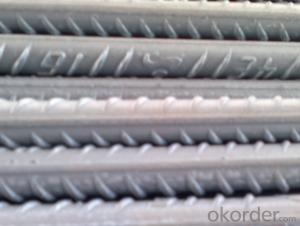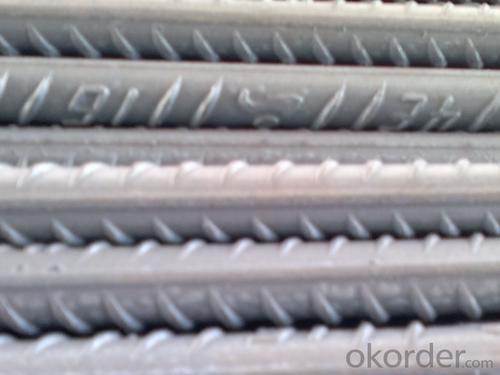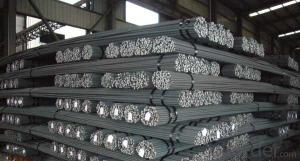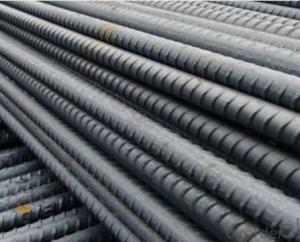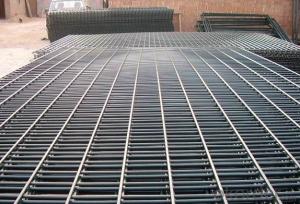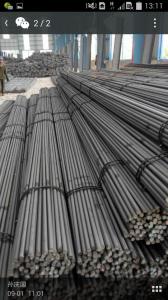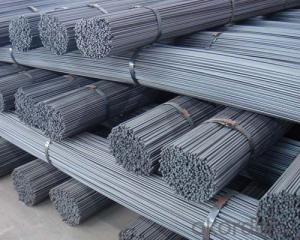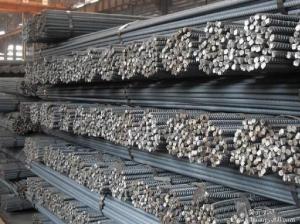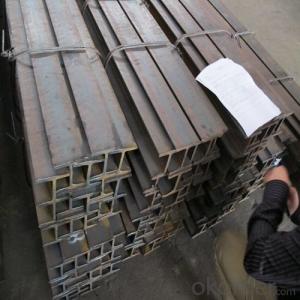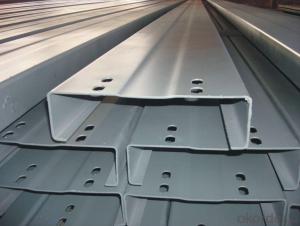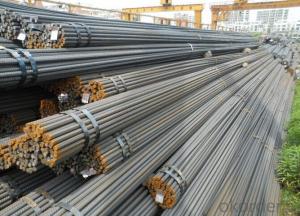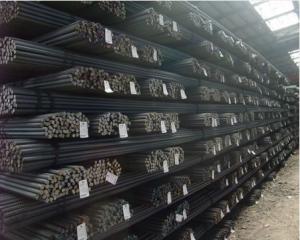Hot Rolled Steel Deformed Bar D-BAR HRB400/HRB500/B500B/B500C/GR40/R60
- Loading Port:
- Tianjin
- Payment Terms:
- TT OR LC
- Min Order Qty:
- 25 m.t.
- Supply Capability:
- 50000 m.t./month
OKorder Service Pledge
OKorder Financial Service
You Might Also Like
Specification
Product Description:
OKorder is offering Hot Rolled Steel Deformed Bar D-BAR HRB400/HRB500/B500B/B500C/GR40/R60 at great prices with worldwide shipping. Our supplier is a world-class manufacturer of steel, with our products utilized the world over. OKorder annually supplies products to European, North American and Asian markets. We provide quotations within 24 hours of receiving an inquiry and guarantee competitive prices.
Product Applications:
Hot Rolled Steel Deformed Bar D-BAR HRB400/HRB500/B500B/B500C/GR40/R60 are ideal for structural applications and are widely used in the construction of buildings and bridges, and the manufacturing, petrochemical, and transportation industries.
Product Advantages:
OKorder's Hot Rolled Steel Deformed Bar D-BAR HRB400/HRB500/B500B/B500C/GR40/R60 are durable, strong, and resist corrosion.
Main Product Features:
· Premium quality
· Prompt delivery & seaworthy packing (30 days after receiving deposit)
· Corrosion resistance
· Can be recycled and reused
· Mill test certification
· Professional Service
· Competitive pricing
Product Specifications:
deformed steel bar grade 40
material: HRB400, BS4449 GR460B
size: 8-36mmx12m.
short delivery time with bulk or container
packing: Mill standard export packing in bundles/coil, around 2tons/bundle.
country of Origin: China
delivery Time: Within a 35 days
Shipment: by bulk vessel or by container
Standard | GB | HRB400 | |
Diameter | 6mm,8mm,10mm,12mm,14mm,16mm,18mm,20mm, 22mm,25mm,28mm,32mm,36mm,40mm,50mm | ||
Length | 6M, 9M,12M or as required | ||
Place of origin | Hebei, China mainland | ||
Advantages | exact size, regular package, chemical and mechanical properties are stable. | ||
Type | Hot rolled deformed steel bar | ||
Brand name | DRAGON | ||
Usage and Applications of HRB400 Deformed Steel Bar:
Deformed bar is widely used in buildings, bridges, roads and other engineering construction. Big to highways, railways, bridges, culverts, tunnels, public facilities such as flood control, dam, small to housing construction, beam, column, wall and the foundation of the plate, deformed bar is an integral structure material. With the development of world economy and the vigorous development of infrastructure construction, real estate, the demand for deformed bar will be larger and larger..
Packaging & Delivery of HRB400 Deformed Steel Bar:
Packaging Detail: products are packed in bundle and then shipped by container or bulk vessel, deformed bar is usually naked strapping delivery, when storing, please pay attention to moisture proof. The performance of rust will produce adverse effect.
Each bundle weight: 2-3MT, or as required
Payment term: TT or L/C
Delivery Detail: within 45 days after received advanced payment or LC.
Label: to be specified by customer, generally, each bundle has 1-2 labels
Trade terms: FOB, CFR, CIF
FAQ:
Q1: Why buy Materials & Equipment from OKorder.com?
A1: All products offered byOKorder.com are carefully selected from China's most reliable manufacturing enterprises. Through its ISO certifications, OKorder.com adheres to the highest standards and a commitment to supply chain safety and customer satisfaction.
Q2: How do we guarantee the quality of our products?
A2: We have established an advanced quality management system which conducts strict quality tests at every step, from raw materials to the final product. At the same time, we provide extensive follow-up service assurances as required.
Q3: How soon can we receive the product after purchase?
A3: Within three days of placing an order, we will begin production. The specific shipping date is dependent upon international and government factors, but is typically 7 to 10 workdays.
Q4: What makes stainless steel stainless?
A4: Stainless steel must contain at least 10.5 % chromium. It is this element that reacts with the oxygen in the air to form a complex chrome-oxide surface layer that is invisible but strong enough to prevent further oxygen from "staining" (rusting) the surface. Higher levels of chromium and the addition of other alloying elements such as nickel and molybdenum enhance this surface layer and improve the corrosion resistance of the stainless material.
Q5: Can stainless steel rust?
A5: Stainless does not "rust" as you think of regular steel rusting with a red oxide on the surface that flakes off. If you see red rust it is probably due to some iron particles that have contaminated the surface of the stainless steel and it is these iron particles that are rusting. Look at the source of the rusting and see if you can remove it from the surface.
Images:
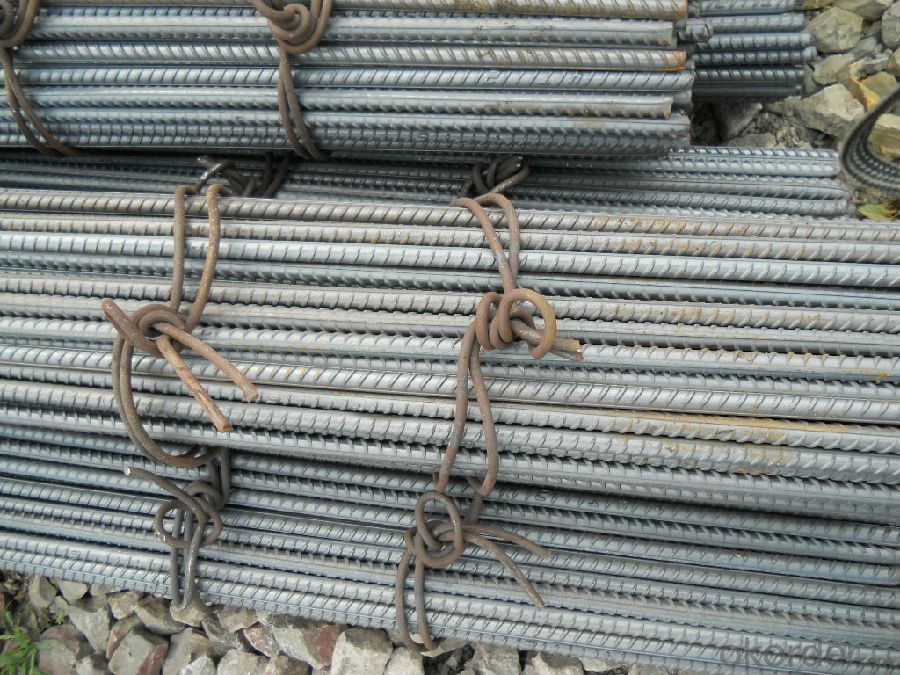
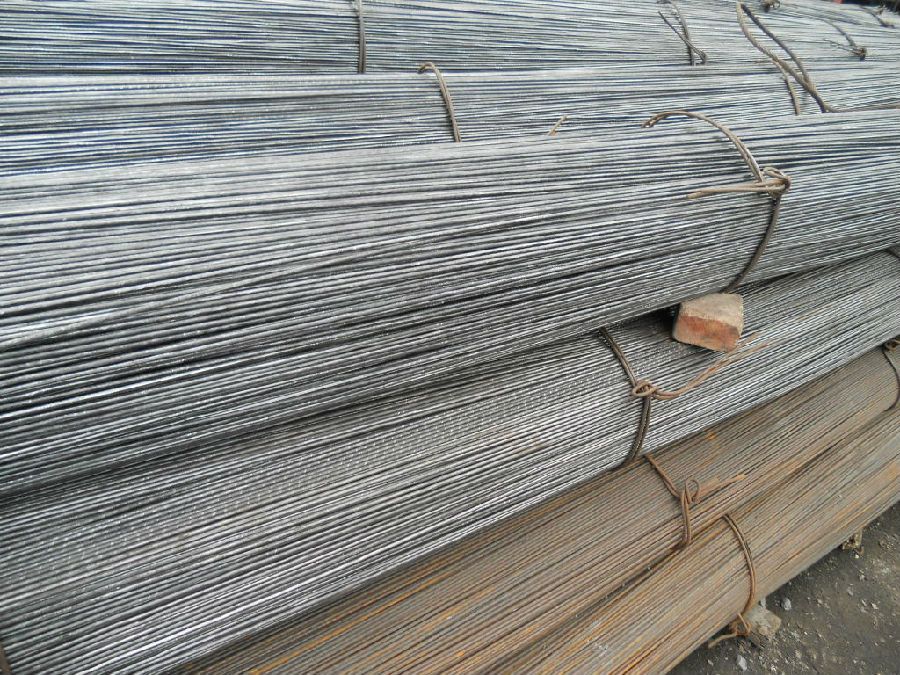
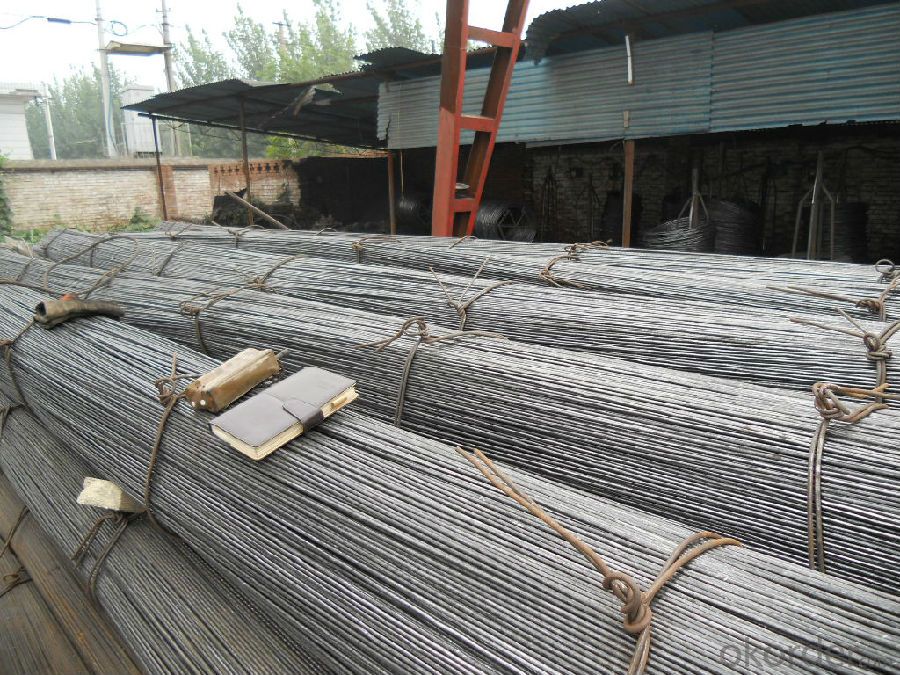
- Q: Are steel rebars available in different shapes and profiles?
- Steel rebars are available in a variety of shapes and profiles, not just the plain round bar. The plain round bar is circular and smooth, but there are also deformed bars with ribs or indentations along their length. These ribs improve the adhesion between the rebars and the surrounding concrete, making the structure stronger and more stable. Steel rebars can be found in different sizes and lengths to meet different construction needs. Square bars, flat bars, and T-shaped bars are examples of other profiles available. These different shapes and profiles give engineers and builders the flexibility to choose the most suitable type of steel rebar for their specific construction projects.
- Q: What is the effect of improper storage on the corrosion resistance of steel rebars?
- Improper storage of steel rebars can significantly reduce their corrosion resistance. Factors such as exposure to moisture, high humidity, direct contact with water, and inadequate ventilation can accelerate the corrosion process. This can lead to the formation of rust and ultimately compromise the structural integrity of the rebars. Therefore, proper storage is crucial to maintain the corrosion resistance and overall durability of steel rebars.
- Q: What is the recommended lap length for steel rebars in concrete joints?
- The recommended lap length for steel rebars in concrete joints typically depends on factors such as the type of structure, loading conditions, and design codes. However, a commonly used lap length for steel rebars in concrete joints is around 40 times the diameter of the rebar.
- Q: Can steel rebars be used in structures with high aesthetic requirements?
- Yes, steel rebars can be used in structures with high aesthetic requirements. While rebars are primarily used for their structural strength and reinforcement purposes, they can also be incorporated into architectural designs to enhance the visual appeal of a structure. With various surface finishes and coatings available, steel rebars can be customized to meet specific aesthetic requirements, ensuring they blend seamlessly with the overall design and aesthetics of the structure.
- Q: Can steel rebars be welded to other steel components?
- Yes, steel rebars can be welded to other steel components. Welding is a common method used to connect steel rebars to various steel structures or components in construction projects. The process involves heating the rebars and the steel components to a high temperature, melting them, and then allowing them to cool and solidify, creating a strong and durable bond. Welding steel rebars to other steel components is a widely accepted practice that helps to enhance the overall structural integrity and stability of the construction. It provides a reliable connection between the rebars and the steel components, ensuring that they work together effectively to withstand the forces and loads placed on them. However, it is important to follow proper welding techniques and adhere to relevant industry standards and guidelines to ensure a successful and safe welding process.
- Q: What is the effect of carbon content on the strength of steel rebars?
- The strength of steel rebars is significantly affected by their carbon content. Generally, a higher carbon content results in increased strength and hardness in the steel rebars. This occurs because carbon atoms create strong chemical bonds with iron atoms in the steel matrix, resulting in a more rigid and durable material. When carbon is added to the steel, it forms carbides, which are crystalline compounds that enhance the hardness and strength of the steel. The presence of these carbides improves the steel rebars' resistance to deformation, making them suitable for applications that require high strength, such as construction and infrastructure projects. Nevertheless, it is important to consider that there is a limit to how much carbon can be added to the steel rebars to enhance their strength. Excessive carbon content can make the steel brittle and prone to cracking when subjected to stress. This is because excessive carbon atoms can form large clusters of carbides, weakening the overall structure of the steel rebars. Therefore, it is crucial to carefully balance the carbon content in steel rebars to achieve the desired strength and toughness. Depending on the specific application and requirements, different levels of carbon can be utilized to optimize the strength and performance of the steel rebars. In conclusion, the carbon content directly affects the strength of steel rebars. Increasing the carbon content can enhance their strength and hardness, but excessive levels of carbon can result in brittleness. Hence, finding the appropriate balance of carbon content is essential to ensure the optimal strength and performance of steel rebars in various construction applications.
- Q: Are steel rebars affected by magnetic fields?
- Yes, steel rebars are affected by magnetic fields. Steel is a ferromagnetic material, which means it can be magnetized and is attracted to magnets. Thus, the presence of a magnetic field can cause steel rebars to experience magnetic forces or become magnetized themselves.
- Q: Can steel rebars be used in other applications besides construction?
- Yes, steel rebars can be used in other applications besides construction. They are commonly utilized in various industries such as automotive, manufacturing, and infrastructure projects, where their high strength and durability make them suitable for reinforcement purposes. Additionally, steel rebars can also be employed in sculptures, art installations, and DIY projects due to their malleability and versatility.
- Q: What is the process of reinforcing existing concrete structures with steel rebars?
- Enhancing the strength and durability of existing concrete structures with steel rebars involves a series of steps. To begin, a thorough assessment of the concrete structure is conducted to determine its condition and identify areas in need of reinforcement. This involves inspecting the concrete for cracks, signs of degradation, or any other structural issues. Once the areas requiring reinforcement are identified, the next step is surface preparation. This involves cleaning the concrete surface to remove any loose debris, dirt, or contaminants that could hinder the bonding of the rebars with the concrete. Various methods, such as pressure washing or sandblasting, can be used for this purpose. Following surface preparation, the rebars are strategically placed within the concrete structure. The positioning and spacing of the rebars are crucial to ensure optimal reinforcement and structural integrity. This is typically accomplished by drilling holes or creating channels in the concrete where the rebars will be placed. Afterward, the rebars are inserted into the holes or channels, ensuring proper alignment and securing. The rebars are typically cut to the required length and bent into the desired shape to meet the specific reinforcement needs of the structure. Once the rebars are in place, they are anchored or secured to the existing concrete by various means. This can be achieved through the use of epoxy adhesive, mechanical anchors, or embedding the rebars into fresh concrete poured around them. Finally, the concrete is restored to its original condition, covering the rebars and creating a smooth and even surface. This may involve patching up any holes or channels created during the reinforcement process and finishing the surface to match the surrounding concrete. In conclusion, the process of reinforcing existing concrete structures with steel rebars necessitates careful planning, proper surface preparation, precise placement of rebars, secure anchoring, and appropriate finishing to achieve a strengthened and long-lasting structure.
- Q: What are the different types of steel rebars used in parking structures?
- Parking structures commonly utilize various types of steel rebars for reinforcement and structural integrity. The choice of rebar type depends on factors such as design requirements, load-bearing capacity, and the construction environment. 1. Mild Steel Rebars, also called black rebars, are the most widely used type. They possess a carbon content ranging from 0.15% to 0.30%, ensuring high ductility and weldability. With excellent tensile strength and cost-effectiveness, they are suitable for most parking structure applications. 2. High-Strength Rebars, also known as deformed rebars, are made from carbon steel with additional alloying elements like manganese, silicon, and chromium. This enhances their strength, making them ideal for structures with higher load-bearing requirements or larger spans. They find common use in multi-level parking structures or areas with heavy traffic loads. 3. Epoxy-Coated Rebars involve applying a protective layer of epoxy resin to mild steel rebars. This coating resists corrosion and prevents direct contact with the concrete, minimizing the risk of rust and structural damage. Epoxy-coated rebars are frequently used in parking structures near coastal areas or regions with high humidity, where corrosion is a major concern. 4. Stainless Steel Rebars are highly resistant to corrosion and are employed in parking structures exposed to aggressive environments, such as near the sea or areas with high chloride content. These rebars consist of an alloy of steel and chromium, with additional elements like nickel and molybdenum, ensuring superior corrosion resistance and long-term durability. It is important to consult a structural engineer or construction professional when selecting the appropriate rebar type for a parking structure. They will consider project requirements, local building codes, and environmental conditions to ensure the parking structure's longevity and safety.
Send your message to us
Hot Rolled Steel Deformed Bar D-BAR HRB400/HRB500/B500B/B500C/GR40/R60
- Loading Port:
- Tianjin
- Payment Terms:
- TT OR LC
- Min Order Qty:
- 25 m.t.
- Supply Capability:
- 50000 m.t./month
OKorder Service Pledge
OKorder Financial Service
Similar products
Hot products
Hot Searches
Related keywords
